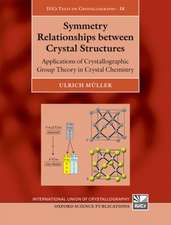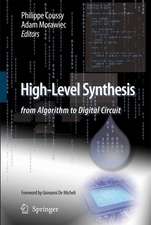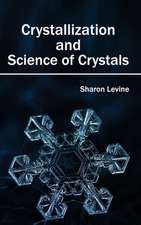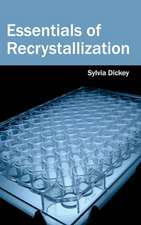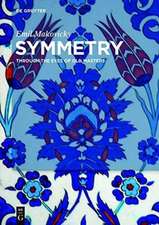Orientations and Rotations: Computations in Crystallographic Textures
Autor Adam Morawiecen Limba Engleză Hardback – 8 oct 2003
| Toate formatele și edițiile | Preț | Express |
|---|---|---|
| Paperback (1) | 636.30 lei 6-8 săpt. | |
| Springer Berlin, Heidelberg – 30 noi 2010 | 636.30 lei 6-8 săpt. | |
| Hardback (1) | 642.68 lei 6-8 săpt. | |
| Springer Berlin, Heidelberg – 8 oct 2003 | 642.68 lei 6-8 săpt. |
Preț: 642.68 lei
Preț vechi: 756.09 lei
-15% Nou
Puncte Express: 964
Preț estimativ în valută:
122.99€ • 127.06$ • 102.36£
122.99€ • 127.06$ • 102.36£
Carte tipărită la comandă
Livrare economică 25 martie-08 aprilie
Preluare comenzi: 021 569.72.76
Specificații
ISBN-13: 9783540407348
ISBN-10: 3540407340
Pagini: 212
Ilustrații: X, 200 p.
Dimensiuni: 155 x 235 x 17 mm
Greutate: 0.48 kg
Ediția:2004
Editura: Springer Berlin, Heidelberg
Colecția Springer
Locul publicării:Berlin, Heidelberg, Germany
ISBN-10: 3540407340
Pagini: 212
Ilustrații: X, 200 p.
Dimensiuni: 155 x 235 x 17 mm
Greutate: 0.48 kg
Ediția:2004
Editura: Springer Berlin, Heidelberg
Colecția Springer
Locul publicării:Berlin, Heidelberg, Germany
Public țintă
Professional/practitionerCuprins
1 Preliminaries.- 2 Parameterizations.- 3 Geometry of the Rotation Space.- 4 More on Small Orientation Changes.- 5 Some Statistical Issues.- 6 Symmetry.- 7 Misorientation Angle and Axis Distributions.- 8 Crystalline Interfaces and Symmetry.- 9 Crystallographic Textures.- 10 Diffraction Geometry.- 11 Effective Elastic Properties of Polycrystals.- References.
Recenzii
From the reviews of the first edition:
"Morawiec presents a … detailed discussion of the geometry of the rotation space and corresponding elementary regions due to specific crystal or sample symmetries. … A significant advantage of the book is, that it closes the gap between the formal analysis of orientations and continuum mechanics. … a mathematically precise approach containing a large number of instructing and helpful problems and comments is given. Thus, this book is highly recommendable for students, engineers and scientists working in the field of crystallographic texture analysis." (T. Böhlke, Technische Mechanik, Vol. 26 (1), 2006)
"The book gives an introduction to the techniques used in the description of crystallographic textures for the orientational relationships between the various parts. … The text is very readable. Its approach is mathematical, but not abstract. … The rather schematic treatment in the book of a cubic-orthorhombic case is the closest to the practical work. … in total, the book presents a clear introduction to the basic mathematics needed for specifying the orientational relationships playing a role in the description of textures." (T.Janssen, Mathematical Reviews, 2006 b)
"Essentially, Orientations and Rotations treats the mathematical and computational foundations of texture analysis. It contains an extensive and thorough introduction to parameterizations and geometry of the rotation space. Since the notions of orientations and rotations are of primary importance for science and engineering, the book can be useful for a very broad audience using rotations in other fields." (Zeitschrift für Kristallographie, Issue 10, 2004)
"The mathematics of orientation, which this book addresses in great detail, is … very relevant to Earth Science. … I will certainly use it as a reference. … the book is a detailed and careful treatment of the topic which pulls together many pieces ofwork previously scattered through the literature, and makes a coherent whole." (John Wheeler, Geological Magazine, Vol. 143 (4), 2006)
"Morawiec presents a … detailed discussion of the geometry of the rotation space and corresponding elementary regions due to specific crystal or sample symmetries. … A significant advantage of the book is, that it closes the gap between the formal analysis of orientations and continuum mechanics. … a mathematically precise approach containing a large number of instructing and helpful problems and comments is given. Thus, this book is highly recommendable for students, engineers and scientists working in the field of crystallographic texture analysis." (T. Böhlke, Technische Mechanik, Vol. 26 (1), 2006)
"The book gives an introduction to the techniques used in the description of crystallographic textures for the orientational relationships between the various parts. … The text is very readable. Its approach is mathematical, but not abstract. … The rather schematic treatment in the book of a cubic-orthorhombic case is the closest to the practical work. … in total, the book presents a clear introduction to the basic mathematics needed for specifying the orientational relationships playing a role in the description of textures." (T.Janssen, Mathematical Reviews, 2006 b)
"Essentially, Orientations and Rotations treats the mathematical and computational foundations of texture analysis. It contains an extensive and thorough introduction to parameterizations and geometry of the rotation space. Since the notions of orientations and rotations are of primary importance for science and engineering, the book can be useful for a very broad audience using rotations in other fields." (Zeitschrift für Kristallographie, Issue 10, 2004)
"The mathematics of orientation, which this book addresses in great detail, is … very relevant to Earth Science. … I will certainly use it as a reference. … the book is a detailed and careful treatment of the topic which pulls together many pieces ofwork previously scattered through the literature, and makes a coherent whole." (John Wheeler, Geological Magazine, Vol. 143 (4), 2006)
Textul de pe ultima copertă
The book is about mathematical and computational foundations of texture analysis. Numerical techniques are indispensable in texture analysis, so the book is primarily addressed to researchers and students using these techniques in practice.
Orientations and Rotations is very different from other books on textures in its content and focal point. Major part of the book is devoted to orientations and rotations in general. Opening chapters contain an extensive and thorough introduction to rotations in three dimensions (including parameterizations and geometry of the rotation space). Further chapters are also general but they will be of interest for readers dealing with orientations of symmetric objects. This subject is essential for crystallographic textures since most crystal structures are symmetric. The final chapters concern more practical aspects of textures (such as the determination of orientations from diffraction patterns and the calculation of effective elastic properties of polycrystals).
The book will be of interest for scientists working on plasticity, grain boundaries, recrystallisation, grain growth, and numerous other issues in which textures must be taken into account. Because of the extensive parts on rotations in general, the book can be valuable for everyone dealing with rotations
Orientations and Rotations is very different from other books on textures in its content and focal point. Major part of the book is devoted to orientations and rotations in general. Opening chapters contain an extensive and thorough introduction to rotations in three dimensions (including parameterizations and geometry of the rotation space). Further chapters are also general but they will be of interest for readers dealing with orientations of symmetric objects. This subject is essential for crystallographic textures since most crystal structures are symmetric. The final chapters concern more practical aspects of textures (such as the determination of orientations from diffraction patterns and the calculation of effective elastic properties of polycrystals).
The book will be of interest for scientists working on plasticity, grain boundaries, recrystallisation, grain growth, and numerous other issues in which textures must be taken into account. Because of the extensive parts on rotations in general, the book can be valuable for everyone dealing with rotations
Caracteristici
Addresses primarily students and researchers using numerical techniques in the field of crystallographic textures Collects information presently spread over numerous publications Provides a handy tool for those writing texture-related computer programs Gives a deep understanding of rotations and orientations applicable far beyond crystallography




